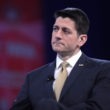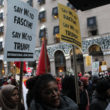I was covering the Conservative Political Action Conference (CPAC) in February 2008 when right-wing radio commentator Laura Ingraham introduced Mitt Romney as “the conservative’s conservative.” Ingraham had no clue that Romney would conclude his speech by accounting that he was withdrawing from the race, handing the nomination to John McCain.
After Romney ended his speech, thousands of despairing college-age CPACers filed out of the ballroom of the D.C. Omni Shoreham, some of them dropping their orange foam “Mitt mitts” on the floor as they departed, others holding their arms rigid in cruel parody of the physically impaired Vietnam veteran John McCain.
The crowd booed McCain when he followed Romney onto the podium later in the day, most loudly when he mentioned immigration.
That Romney was the choice of conservatives four years ago, and this year was a disappointment to the right after he outlasted Newt Gingrich, Rick Perry, Herman Cain, and Rick Santorum, tells us how far and how fast the Republican Party moved from right to extreme right.
I was in eastern Oregon following Democratic Senator Jeff Merkley in the summer of 2009 when that right lurch began, as congressional town-hall meetings began to be hijacked by angry, white, middle-class “patriots.” By the second day of meetings, a staffer was on the phone with a county sheriff, requesting armed protection for the senator.
The town-hall meetings swept across the county in a summer of hate, as the insurgent Tea Party began to dominate the Republican Party.
After the 2012 elections, when the Tea Party provided the Republicans the enthusiasm and energy to take over the House, the GOP makeover was complete. Extremist “Young Guns”—Majority Leader Eric Cantor, Majority Whip Kevin McCarthy, Wisconsin Congressman Paul Ryan—dominated the leadership of the most conservative House of Representatives in modern history.
As Thomas Mann and Norman Ornstein wrote in an April 2012 Washington Post op-ed, based on their book It’s Even Worse than It Looks: “The GOP has become an insurgent outlier in American politics. It is ideologically extreme; scornful of compromise; unmoved by conventional understanding of facts, evidence and science, and dismissive of its political opposition.”
Mitt Romney was a man out of time. A conservative’s conservative in 2008, by 2012 he was a moderate in a party intolerant of moderation. His nomination recalls Lisa Marie Presley’s marriage to Michael Jackson. It had to be built on a series of elaborate deceptions in order to sell it to the public.
First Mitt Romney had to convince movement conservatives that he was one of them. They never bought it. He had been a centrist governor in a liberal state.
Then he had to sell voters a counterfactual narrative: that his experience in the private sector involved the creation of jobs. They never bought it. Bain Capital’s private equity acquisitions on occasion saved jobs; they rarely created jobs.
The one big lie on which Romney’s campaign foundered in the week before Election Day was not out of character with a campaign predicated on deceit. It was nonetheless shocking. And it ended any hope of a last-minute turnaround for the campaign.
Romney’s candidacy went from moribund to dead when someone on his staff persuaded him to turn a line from a stump speech—that Jeep was shipping American jobs to China (which was a lie)—into a TV ad and then a radio spot, both tailored for Ohio media markets. The radio spot also added GM to the list of U.S. automakers shipping U.S. jobs to China.
“I feel obliged to unambiguously restate our position,” Chrysler CEO Sergio Marchionne wrote in an e-mail to GM workers that was leaked to the Detroit News. “Jeep production will not be moved from the United States to China.” (Chrysler owns Jeep.)
GM did more: It took Romney to task for lying. “At this stage, we’re looking at Hubble Telescope-length distances between campaign ads and reality,” said GM spokesman Greg Martin. “GM’s creating jobs in the U.S. and repatriating profits back to this country should be a source of bipartisan pride. We’ve clearly entered some parallel universe during these last few days. No amount of campaign politics at its cynical worst will diminish our record of creating jobs in the U.S. and repatriating profits back to this country.”
These two statements from auto-company heads defined the high ground from which Obama attacked Romney until the polls closed. Ohio was lost.
As was more than $5 billion spent to attack a president whom voters re-elected despite the highest sustained unemployment rate since the Great Depression.
In our perverse electoral system, the party’s search for the next candidate began when the polls closed on November 6.
By the next CPAC gathering in March, 10,000 movement conservatives who convene in Washington—and the elected officials who appear to genuflect before them—will be looking for a true conservative.
CPAC’s right-wing theocrats have already begun. “It should have been a landslide if Romney had run as a true conservative,” Brent Bozell of Media Research Center told the blog The Hill on the day after the election. “Conservatives are saying never again are we going to nominate a big-government, establishment Republican for president,” said right-wing direct-mail pioneer Richard Viguerie on NPR the following day.
Look for the Party of Lincoln to move further to the right and nominate a candidate who will again have to fool all of the people some of the time.






0 Comments